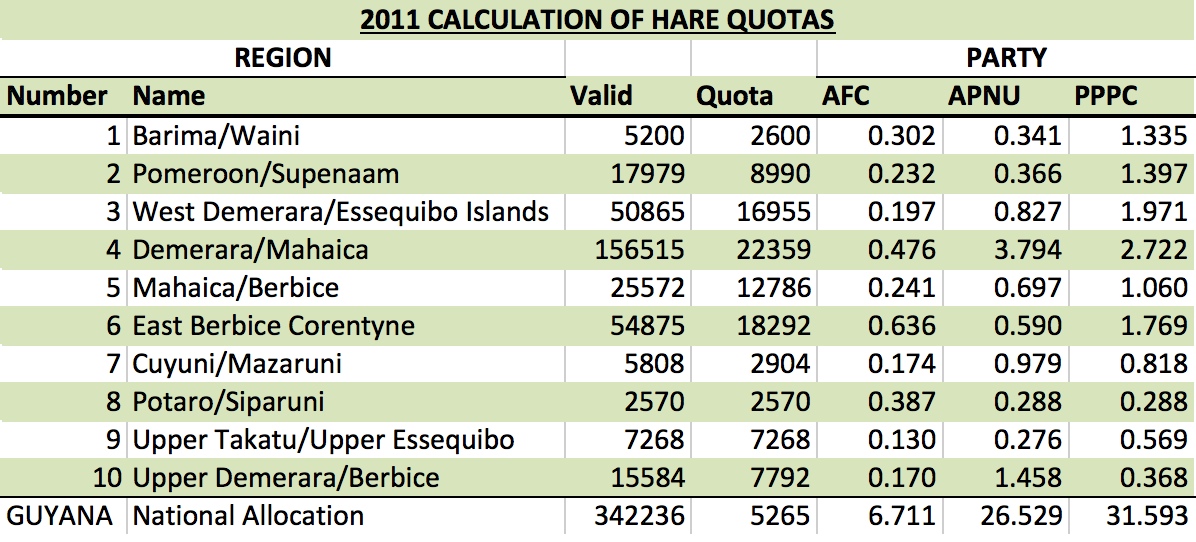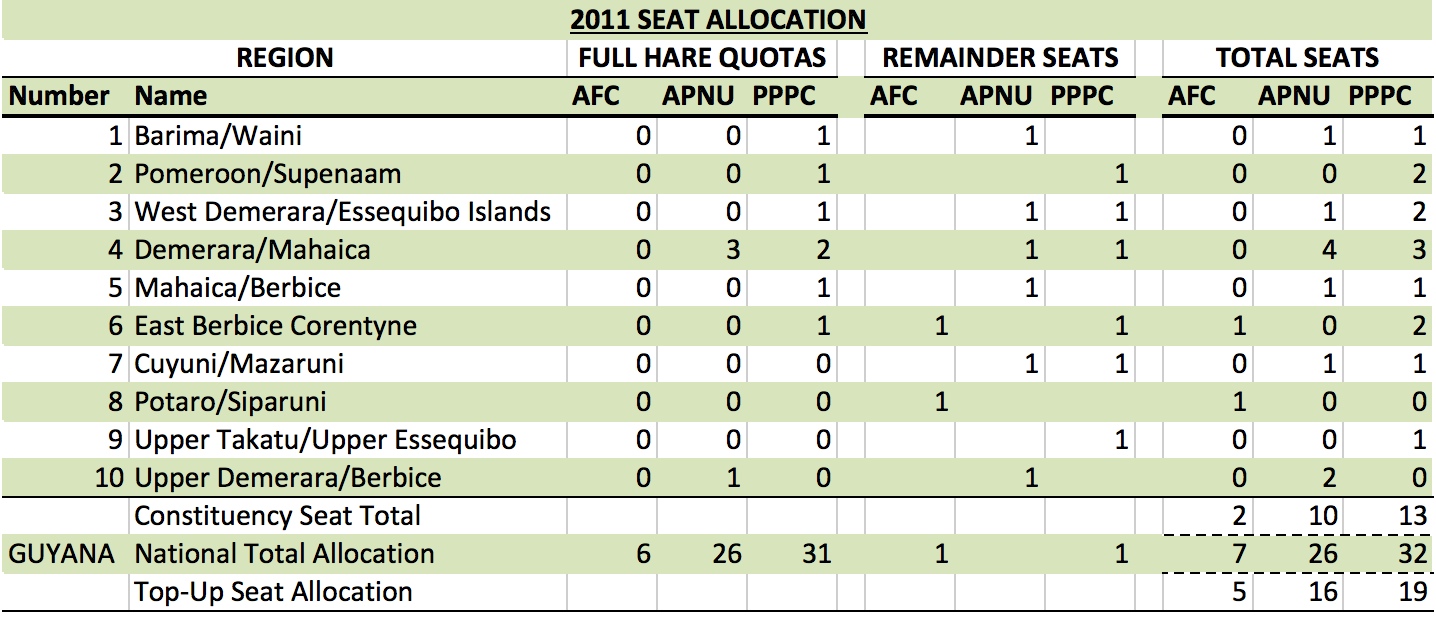Guyana 1 (1964)
Voters cast a single vote for a party list that was used to allocate 53 seats in a single national constituency by the largest remainder system of proportional representation with a Droop quota–valid votes divided by the number of seats plus 1. Lists were closed.
In addition to the 53 elected seats, there were 12 nominated members. Each of the 10 regional councils selected one member. The National Congress of Local Democratic Organizations chose the final two members.
Guyana 2 (1968-97)
Voters cast a single vote for a party list that was used to allocate 53 seats in a single national constituency by the largest remainder system of proportional representation with a Hare quota–valid votes divided by the number of seats. (Note: I am unclear if Guyana utilized the Droop or the Hare quota in 1968–it made no difference to the final allocation–but the Hare quota was definitely used starting in 1973.)
Guyana began using its unique system to allocate the seats won by each party to candidates in 1968. All of a party’s candidates in each constituency and at the national level are listed in alphabetical order. After the election, the party chair then selects candidates off the list. As a result, the list is not only closed but voters do not know the order of the list.
In addition to the 53 elected seats, there were 12 nominated members. Each of the 10 regional councils selected one member. The National Congress of Local Democratic Organizations chose the final two members.
Guyana 3 (2001-)
Voters cast a single vote for a party list that is used twice to allocate a total of 65 seats under the current electoral system. There are no longer any nominated members.
In 10 geographical constituencies that correspond to Guyana’s 10 administrative regions, 25 seats are allocated according to the largest remainder system of proportional representation with a Hare quota.
The remaining 40 mandates are allocated as top-up seats to render the overall allocation of 65 seats proportional to the national vote. A proportionate allocation of the 65 seats according to the largest remainder system with a Hare quota is first calculated. Any mandates won in the geographical constituencies are then subtracted from each party’s total to determine the number of top-up seats allotted to each party.
Guyana continues to apply its unique system to allocate the seats won by each party to candidates. All of a party’s candidates in each constituency and at the national level are listed in alphabetical order. After the election, the party chair then selects candidates off the list. As a result, the list is not only closed but voters do not know the order of the list.
The following table shows the apportionment of seats:
Reviewing the 2011 election allocation shows how the process works. The following table shows the 2011 election results:
 The next table shows the calculation of the Hare quota–valid votes divided by the number of seats–for each constituency as well as Guyana as a whole. It also reveals how many multiples of the Hare quota were won by each party–votes received by the party divided by the Hare quota. TUF is excluded from this table as it received too few votes to gain any seats.
The next table shows the calculation of the Hare quota–valid votes divided by the number of seats–for each constituency as well as Guyana as a whole. It also reveals how many multiples of the Hare quota were won by each party–votes received by the party divided by the Hare quota. TUF is excluded from this table as it received too few votes to gain any seats.
 The final table shows the allocation of seats. First, constituency seats were allocated to parties that won full multiples of the Hare quota. Any remaining seats were then allocated to parties in descending order of remainder votes. (The order can be determined by comparing the portion of the Hare quota calculation to the right of the decimal point.)
The final table shows the allocation of seats. First, constituency seats were allocated to parties that won full multiples of the Hare quota. Any remaining seats were then allocated to parties in descending order of remainder votes. (The order can be determined by comparing the portion of the Hare quota calculation to the right of the decimal point.)
 The same exercise was conducted to determine a proportional allocation of the 65 seats across Guyana–see the second to last line of the above table. The number of constituency seats won by each party was then subtracted from the total seats earned by each party according the national proportional allocation. This final calculation gives the number of top-up seats gained by each party, shown in the last row of the above table.
The same exercise was conducted to determine a proportional allocation of the 65 seats across Guyana–see the second to last line of the above table. The number of constituency seats won by each party was then subtracted from the total seats earned by each party according the national proportional allocation. This final calculation gives the number of top-up seats gained by each party, shown in the last row of the above table.
All that remained was for the party leaders to select winning candidates off of their lists in constituencies and at the national level.
Sources: Guyana Elections Commission (GECOM); Representation of the People Act; Matthias Trefs, “Guyana” in Elections in the Americas: A Data Handbook, Vol. 1, ed. Dieter Nohlen (New York: Oxford University Press 2005), 353-72.

